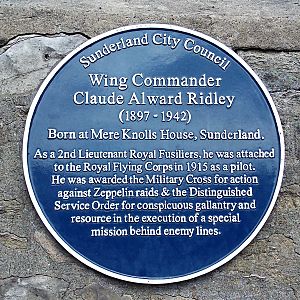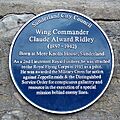Claude Alward Ridley facts for kids
Quick facts for kids
Claude Alward Ridley
|
|
|---|---|

The blue plaque in Sunderland to commemorate the life of Claude Alward Ridley
|
|
| Born | 15 November 1896 Sunderland |
| Died | 27 June 1942 (aged 45) The Dorchester Hotel, London |
| Buried |
St Mary and St Margarets churchyard, Stow Maries, Essex
(51°39′49″N 0°39′01″E / 51.6636°N 0.6502°E) |
| Allegiance | United Kingdom |
| Service/ |
British Army (1914–18) Royal Air Force (1918–42) |
| Years of service | 1914–1928 1939–1942 |
| Rank | Wing Commander |
| Service number | 03036 |
| Commands held | No. 37 Squadron RAF No. 39 Squadron RAF No. 61 Squadron RAF No. 75 Squadron RAF No. 112 Squadron RAF |
| Battles/wars | First World War Second World War |
| Awards | Distinguished Service Order Military Cross |
| Spouse(s) | Lillias Elizabeth McAlpine |
Claude Alward Ridley (born November 15, 1897 – died June 27, 1942) was a very brave British pilot and military officer. He was known for his amazing escape during the First World War. He also helped defend England from German air attacks.
Contents
Early Life and Joining Up
Claude Ridley was born in Sunderland on November 15, 1897. He was the youngest of seven children. His family later moved to Notting Hill in London.
When the First World War began, Claude wanted to fly. He joined the Royal Flying Corps (RFC) in July 1915. Before that, he trained at Sandhurst and became an officer in the Royal Fusiliers.
First World War Adventures
Claude was assigned to No. 3 Squadron. In 1916, he was hurt while fighting on the Western Front. He injured his foot and had to recover in England.
While recovering, he was awarded the Military Cross. This was for shooting down a German Zeppelin in 1916. He was flying from Joyce Green at the time.
The Daring Escape
In April 1916, Claude joined No. 60 Squadron. In August 1916, he was flying a spy into enemy territory in France. His plane broke down near the town of Douai. German soldiers found them and took them prisoner.
But Claude and the spy managed to escape quickly! Claude hid while the spy got him some regular clothes. Then, the spy left Claude to find his own way. While hiding, Claude watched German pilots and even saw a British plane crash.
Claude bravely made his way across France and into Belgium. He finally returned to England through the Netherlands. During his journey, he secretly gathered important information about the German forces. He gave this information to his commanders when he returned.
For his bravery and smart actions, he received the Distinguished Service Order (DSO). The London Gazette newspaper wrote about his "conspicuous gallantry and judgement." Claude was the only pilot from his squadron to escape captivity during the war.
Defending England's Skies
Because of his important spy mission, Claude was pulled from fighting on the front lines. This was to protect him in case he was captured again and mistaken for a spy. He was sent to lead a group called B-Flight at No. 37 Squadron. He was only 19 years old!
From Stow Maries Aerodrome, Claude and his squadron defended southern and eastern England. They fought against German Gotha bombers and Zeppelin raids.
One time, British anti-aircraft guns accidentally shot at Claude's plane. They thought his Sopwith Pup was an enemy aircraft. Claude's engine cover was blown off at 14,000 feet, and he had to make an emergency landing. This was frustrating for him, as he had flown over the gun batteries the day before to show them what his plane looked like.
Claude later commanded other squadrons, including No. 61 Squadron and No. 112 Squadron. Towards the end of the war, he even commanded No. 28 Squadron in Italy. After the war, he commanded No. 75 Squadron and then No. 39 Squadron.
Later Life and Second World War
In January 1925, Claude was promoted to squadron leader. In June of that year, he married Lillias Elizabeth McAlpine. They had three children together.
He left the Air Force in 1928 but was called back in 1939. This was when the Second World War began. During this war, he served as a Wing Commander. He worked in different roles, including with the Leeds University Air Squadron.
Death and Remembrance
Claude Ridley passed away on June 27, 1942, at the Dorchester Hotel in London. His death was due to natural causes. He wished to be buried near Stow Maries aerodrome, where he had served. His grave is in the churchyard of St Mary and St Margaret's Church.
Honoring a Hero
In 2016, a special blue plaque was placed on the house where Claude Ridley lived in Sunderland. This plaque honors his life and achievements.
Military cadet groups in Essex, near the old Stow Maries Aerodrome, also remember him. They compete every year in the Ridley Trophy competition. They race through an assault course to win the trophy.
Images for kids


